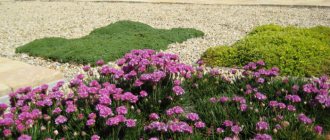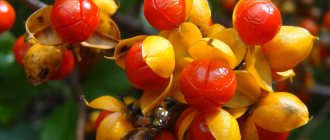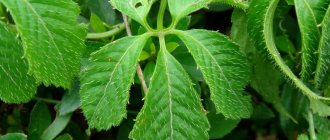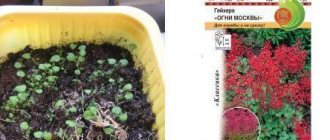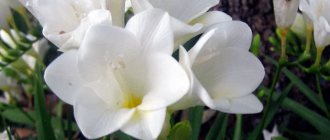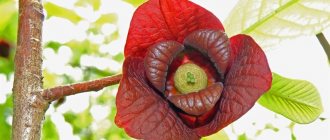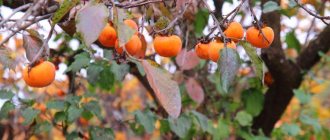Plants » Flowers
0
99
Article rating
Kira Stoletova
Autumn flower, or sedum Vidny, is a perennial succulent plant native to Eastern China, Japan and Korea, has many bright and original varieties. All of them have good endurance and take root well in any climate zone. Let's consider a description of the species, its variety and rules of care in the garden.
Sedum prominent variety
Brief description of cultivation
- Landing. Seeds for seedlings are planted in the first or second month of spring. The sprouts are moved to open ground in late May.
- Flowering occurs in summer and autumn.
- Illumination. Feels good in partial shade, as well as in bright or diffuse rays of the sun.
- The soil. If the soil is fertilized before planting, it can be varied, even with stones.
- Watering. If there is enough rainfall, then additional watering is not required. However, when they are gone for a long time, you need to regularly provide the flower with water.
- Feeding. In spring and autumn, the plant must be fertilized with organic solutions. You can also use fertilizer with minerals (mullein in a ratio of 1 to 10 or bird droppings in a ratio of 1 to 20). Experienced gardeners do not recommend using fresh manure.
- Reproduction. There are three methods: dividing the bush, cuttings or seeds (rarely).
- Pests. Plants are affected by weevils; damage is also noticeable from aphids, thrips and sawfly caterpillars.
- Diseases. Fungal rot affects.
- Properties. A certain part of the representatives of this flower have medicinal characteristics. For example, they treat inflammation and wounds, relieve tumors, regenerate, stop bleeding and tone.
Sedum prominent
How to propagate by division?
This method of sedum propagation requires the least amount of time required to produce a new generation of plants. Young succulents obtained using this method take root well, grow more actively and reach adulthood faster.
Such well-known varieties of sedum as:
- ordinary;
- Morgana;
- red-colored;
- Siebold;
- tall;
- thick-leaved.
Only healthy, well-developed and strong bushes over 4 years old are suitable for the procedure. The division of mother bushes is carried out in early spring.
The sequence of actions is as follows:
the mother plant is carefully removed from the pot along with a lump of earth on the roots; inspect the root ball, remove damaged, diseased and dry root fragments; divide the bush into parts manually or using a sharp knife or garden pruners.
The plant should be divided so that each part has roots and shoots with buds and growing points.
After the procedure, the cut sites and traces of damage on the roots and stems should be treated with any fungicidal preparation and sprinkled with crushed charcoal.
After treatment, the cuttings are dried in the shade for 1-2 hours. Next, they are planted in pots with loose soil mixture. After planting, containers with divisions are placed in a warm and bright room, protected from drafts and direct sunlight.
By cutting and dividing mother bushes, you can easily get a new generation of young succulents
Ease of propagation is an important characteristic feature of sedums, which has led to their popularity among experienced and novice gardeners.
For more information about sedum, watch the video.
Features of sedum
A plant such as sedum exists in the form of shrubs and subshrubs; there are perennial representatives and those that live only a year. The leaves are fleshy in structure, entire and sessile. There are also differences in shape and size. Those inflorescences that are located on the side or on top can also be of different shapes and resemble umbrellas, scutes, and brushes. They consist of flowers of different colors of bisexual species. The plant blooms in summer or autumn. Bees love to eat this plant, so it produces a lot of honey. Sedums of a tropical type are usually chosen for growing at home. And sedums in the garden are those varieties that are resistant to frost and live for many years. Their stems creep or stand straight. Regardless of the species, all of them are drought-resistant and love light. But when there is a little shade, they also feel good. Related plants include Kalanchoe, Echeveria, Spotted Petal and Juvenile.
Types and varieties
Sedums are divided into ground cover plants, sedum proper (Sedum), and sedums (Hylotelephium), taller plants that are a subgenus of sedum. The following types of sedum are most often grown in gardens:
Large sedum (Sedum telephium)
Or large sedum, or sedum, or telephium sedum (Hylotelephium triphyllum), or purple sedum (Sedum purpureum), or legume grass, or crow lard, or live grass, or hare cabbage - a perennial honey plant 25-30 cm high with thick erect stem, sessile flat alternate or opposite leaves, oval and serrated along the edges. Sedum blooms in the second half of summer with red or greenish-yellow flowers, collected in dense corymbose panicles on the tops of the stems. In nature, it can be found in the temperate climate of Asia and Europe on forest edges, clearings, bushes, pine forests and on the slopes of ravines.
This is a medicinal sedum, the leaves of which are used in folk medicine as a strengthening and tonic. Large sedum has several subspecies:
- ordinary legume - with dark purple inflorescences;
- ordinary large - with yellowish or greenish-white inflorescences;
- common ordinary - differs from the previous subspecies in the shape of the leaves narrowed to the base;
- common Ruprechta is a subspecies with creamy white flowers.
Breeders have developed many varieties of sedum, and all of them are in demand in gardening. The most popular varieties of sedum are:
- sedum Matrona is a powerful plant up to 60 cm high with large blue-green leaves, reddening at the edges, on dark purple stems. Inflorescences are light pink;
- Black Jack is a plant up to 40 cm high with bluish-purple foliage and dense inflorescences of pink flowers;
- Linda Windsor - a bush with erect dark burgundy stems, dark red leaves and ruby inflorescences;
- Strawberries and Cream is a hybrid up to 40 cm high with green leaves and reddish-pink buds that open into cream flowers, which is why the inflorescences look two-colored;
- Picolette is a compact variety up to 30 cm high with small red-bronze leaves with a metallic tint and dense pink inflorescences.
Also popular are the large sedum varieties Ruby Glow, Rosie Glow, Bon-bon, Vera Jamieson, Green Expectations, Gooseberry Full, Hub Gray, Crazy Raffles, Xenox and others;
White sedum (Sedum album)
Soapwort, beewort, six-week-old, living grass, lady's flower - found in nature in Russia, the Caucasus, Western Europe, Asia Minor and North Africa. This species received its name because of its white fragrant flowers, collected in a paniculate inflorescence consisting of several branches. It is an evergreen perennial that forms mats up to 5 cm high, with short vegetative branches and plump oval curled elliptical leaves up to 10 cm long.
White sedum has several varieties:
- white small-flowered - a form with white flowers and never-reddening green spherical leaves;
- white wall - a profusely flowering sedum with purple or bronze leaves and pink flowers;
- white wall Christatum - the overgrown ends of the shoots of this garden form are densely planted with leaves.
The most famous varieties of white sedum:
- Zamanikha: cultivation, properties and contraindications
- Coral Carpet is a sedum about 5 cm high with reddish leaves that turn completely red in autumn;
- France is a tall sedum with long green leaves that gradually turn pink in the bright sun;
- Laconicum is a tall sedum with densely planted green, sometimes reddening leaves;
Sedum acre
Lambs, goose soap, wild pepper, fever grass, young, pimple, ruddy, guillemot, jadrenets - grows in the European part of Russia, Western Siberia, the Caucasus, Asia Minor and North America. The sap of this plant can cause ulcers on the skin, hence the name of the species. Sedum is a plant up to 10 cm high with branched round stems, fleshy, bare, dark green alternate leaves up to 6 mm long, which the plant does not shed even in winter, and golden-yellow flowers up to 1.5 cm in diameter, collected in half umbrellas. This species has a variety of forms:
- Aureum - this sedum has yellowish ends of its shoots in spring;
- Minus - very low-growing sedum with dense small leaves;
- Elegance is a low-growing sedum with variegated curled leaves;
False sedum (Sedum spurium)
Grows in subalpine meadows and on rocky slopes of the Caucasus, Turkey and Iran. It is a winter-hardy perennial with long creeping rhizomes, creeping or ascending stems, fleshy opposite dark green ovate-cuneate leaves, crenate or thickly toothed at the edges and corymbose dense inflorescences consisting of purple or pink flowers. The species has been in culture since 1816. The most popular varieties of false sedum:
- Album is a variety with white flowers and green leaves;
- Bronze Carpet - a variety with pink flowers and leaves that turn bronze in autumn;
- Ruby Mantle is a sedum with purple flowers and dark red leaves;
- Shorbuser Bluth - This sedum has green leaves with a red edge in the spring and red leaves in the fall.
The varieties Erd Blut, Fulda Glut, Purpurteppih, Coccineum, Roseum, Salmoneum and others are also grown in the gardens;
Sedum spectabile (Hylotelephium spectabile)
Or the prominent sedum is native to North Korea, Japan and Northeast China. This is a plant up to half a meter high with thickened tuberous roots, erect stems, bare, large sessile bluish-green leaves of spatulate or oval shape, jagged along the edge, and purple-carmine or lilac-pink flowers up to 1 cm in diameter, collected in half-umbrellas up to 15 cm in diameter. In Europe, this species has been cultivated since 1853, and in Asia much earlier.
Both the main species and its numerous varieties are grown in gardens:
- Iceberg - sedum up to 35 cm high with white flowers;
- Diamond is an old variety with pink flowers with bright anthers and bright pink carpels;
- Septemberglut is a variety with large dark pink inflorescences consisting of small flowers;
- Stardust, Snow Queen - sedum with white flowers;
- Meteor, Carmen - similar-looking sedums with purple inflorescences;
- Autumn Faye - a variety up to half a meter high with greenish-gray leaves and copper-colored inflorescences;
- Neon is a sedum up to 35 cm high with large bright pink inflorescences.
In garden culture, sedums are also grown spatulate-leaved, Alberta, pale yellow, hybrid, dense-leaved, Spanish, Kamchatka, Kuril, carneum, linear, Lydian, pampiniform, Middendorf, multi-stemmed, annual, Oregon, recurved, sedum-shaped, shoot-bearing, divergent, Selskogo, blue, opposite-leaved, dark red, thick-branched, thin, slender, Trolla, narrow-leaved, Forstera, six-rowed and subulate.
Of the sedum plants, the most commonly grown species are white-pink, anakampseros, blanching, viviparous, Siebold, Caucasian, false-representative, whorled, nautesny, Tatarinov, poplar-leaved, Ussuri and Eversa.
Growing sedum from seeds
Growing sedums from seeds is quite easy. The main thing is to take a responsible approach to preparing for this procedure.
Sowing
Seeds are planted in early or mid-spring. The distance between them should be maintained approximately 4-5 centimeters. To begin with, select suitable boxes and fill them with a specially prepared mixture. It consists of sand and garden soil. The top layer is coarse sand. The seedlings are slightly moistened with a spray bottle and covered with film. Glass can also be used for shelter. The finished structure is placed on the bottom of the refrigerator, the temperature of which should vary from zero to 5 degrees above zero. Every day, crops need to be given fresh air and any condensation that has accumulated must be removed. The mixture in the box should always be kept damp. After 15 days, the seedlings are moved to the windowsill, the temperature on which should remain within 19 degrees above zero. New sprouts, as a rule, after 15-30 days will already delight the owner’s eye. Until they appear, you should regularly ventilate the crops, remove moisture from the coating and ensure that the soil moisture level is normal. As soon as it falls, the ground needs to be moistened with a spray bottle.
Growing from seeds
Seeds can also be sown for seedlings in winter. This work is carried out according to the same scheme as in the spring. Only for hardening, the seeds should not be placed in the refrigerator, but inside the greenhouse or deepened into the ground. In mid-spring, the crops will need to be moved indoors so that they can germinate safely.
Growing seedlings
The seedlings of this plant are quite miniature. As soon as you notice that most of them have already sprouted, the covering over them can be removed. When a full-fledged plate, the second in a row, is formed, it is possible to transplant into individual pots. Caring for sprouts consists only of moderate regular watering and light loosening of the soil. 7 days before the planned transplant into open soil, young plants must be hardened off. To achieve this, you should rearrange them daily. Little by little, the time of such hardening needs to be increased.
Reproduction by dividing the bush
This technique is usually used in early spring. By dividing the bush, you can propagate plants that have reached the age of 4-5 years. This procedure is carried out as follows:
- The bush is dug up and divided into 3-4 parts.
- The resulting wounds are sprinkled with crushed charcoal.
- Dry the areas in a cool place for several hours.
- Transfer plants to the ground.
By autumn, sedums planted in this way will develop a powerful root system, and therefore will easily withstand winter cold.
Planting sedum in open ground
Planting sedum and caring for a flower in open ground includes several nuances that should be remembered when planning your work.
Planting sedum
When to plant sedum in open ground
Such work is usually carried out on the twentieth of May, when the likelihood of frost returning is almost zero. The plant is particularly unpretentious and can grow in slight shade and in abundant sunlight. However, it feels best when there is plenty of light.
The area you choose for planting seedlings should be open and free of trees and deciduous shrubs. This rule is important to follow because when the leaves fall in the fall, a weak plant may not be able to break through them in the spring.
Landing rules
If we talk about what kind of soil the plant cannot tolerate, then this is not on the list. It can even exist on rocky soil. However, for luxurious bushes, the soil is fertilized before planting. The procedure is performed using compost or humus. Depressions are made in the ground, leaving approximately 20 centimeters between them. After planting, it is necessary to water generously and after 2-3 years you can expect flowers.
Where and how to plant sedum prominent in your garden plot
The agricultural technology of growing succulents does not make any special demands on the gardener: neither deep botanical knowledge nor the constant presence of prominent sedum near the plantings are absolutely necessary.
Lighting
The plant prefers to grow where there is a lot of light. Even the bright sun at midday does not pose a danger to it; the leaves of some species only acquire a slight purple tint.
The sedum tolerates partial shade normally, but the plant should not be planted in the shade of trees. The decorative quality of the shrubs will suffer greatly.
Selecting a location
The main requirement for choosing a site for planting sedum is the deep occurrence of groundwater and the absence of hollows and lowlands in which water stagnates after heavy rain in the summer or after snow melts during a thaw and in the spring. The plant does not tolerate excess moisture, the rhizome soon rots in waterlogged conditions, and no measures will help save the flower.
The succulent is not particularly vulnerable to drafts or wind. Usually plants are planted in dense groups that are not afraid of strong gusts of wind.
Soil requirements
Accustomed in natural conditions to poor rocky or sandy soils, sedum is prominent and in cultivation is unpretentious to the composition of the soil. The only condition is that the area with heavy clay soil will have to be lightened by adding sand. The acidity of the soil for the flower is quite suitable: neutral or slightly acidic.
Of course, in light fertile soil the plant develops much more actively than in a poorly fertilized area with calcareous soil.
Caring for sedum in the garden
When growing sedums, weeding should be carried out regularly.
But there is a type called caustic soda. Its peculiarity is that it independently gets rid of unnecessary grass. Due to this ability, it is often used in alpine slides and flower beds. But other varieties suffer from weeds. So they definitely need to be removed regularly. Water the plant only at times when there is no natural rainfall for a long time and the earth suffers from drought. The stems are growing well. Therefore, from time to time they need to be trimmed to avoid awkward dimensions. In order for the plant to decorate the garden for a long time, the leaves and flowers that begin to fade should be cut off. There are varieties that have bushes of different colors. Therefore, all green leaves on them also need to be removed. After winter and summer, you need to feed the greens. For this purpose, use:
- Complex mineral nutrition
- Organic feeding
- Bird droppings 1 part to 20
- Mullein infusion 1 part to 10
The use of fresh manure for such purposes is not permitted.
Sedum in the garden
Reproduction of sedum
Those plants that belong to ground cover species can be cut by cuttings even before or after flowering. This is done in the following steps:
- A cutting approximately 8 cm long is taken from the stem.
- The leaves that are located below are removed.
- They are deepened into a loose soil mixture so that there is at least one node in the soil.
- When the cutting has taken root, it can be moved to a new place, where it will grow all the time.
In the spring, the cuttings, when they are cut, should be immediately planted in open ground.
In autumn it’s different. Several cuttings are taken and placed in a vase. From time to time the water inside needs to be changed. When spring comes, such sprouts will already have roots. So by this time they can already be placed in open ground. It happens that even before the onset of spring, cuttings take root. In this case, they should be planted in different pots. Then in the spring they are moved to a new place for a permanent time.
It is important not to forget that in this plant it is possible to immediately root the stems in any parts, completely. If everything is done correctly, then out of 10 seedlings, 7-10 will sprout. To do this you need:
- The soil under the shoots is cleared of weeds, fertilized, leveled and compacted.
- The stems are pressed closely to the ground.
- The soil mixture is laid on top. It includes sand and garden soil.
- This layer is also compacted.
Reproduction of sedum
Large bushes and mature ones that have already reached 4-5 years of age can be propagated by division. Sedum reproduction occurs as follows:
- In spring it is removed from the soil.
- All remaining soil is removed from the root system.
- The bush is divided into several separate bushes so that each has buds and roots.
- The sections are treated with a preparation containing a fungicide.
- The resulting plants are placed in a place where it is cool and there is a lot of shade until excess moisture evaporates from them. This usually takes several hours.
- They are then moved to a new territory.
Transfer
The plant can not be replanted for 5 years and this will not affect its condition. After which it should be rejuvenated. This includes removing old shoots, filling them with new soil and fertilizers down to the level of the roots. If possible, it is best to replant sedum. This is done using the methods described earlier.
Landing rules
The site for planting sedum is prepared in advance - the ground is dug up, the lumps are broken up with a rake, and the area is leveled. The holes are dug at a distance of 20 cm from one another. The size of the holes is determined depending on the size of the root system: their internal volume should be approximately one and a half to two times the volume of the root ball.
A drainage layer of sand or expanded clay is poured onto the bottom of the planting hole, a handful of humus is placed on top, and only then the selected soil from the hole is placed. The rhizome is well straightened, covered with the remaining soil and lightly compacted.
A small ditch is made around the root collar to retain irrigation water. After planting, the plant is moistened and the root space is sprinkled with dry soil.
In one place, sedum grows up to 5 years, then it needs to be rejuvenated. To do this, the flower is dug up, the old half-dead roots are removed, the tuber rhizome is divided into several parts and planted in new holes.
Diseases and pests
This type of plant is known for its resistance to the influence of pathogens. However, problems can still arise. For example, if watering is excessive, summers are cold and there is a lot of rainfall, then this threatens diseases of fungal origin. You can tell that a plant has been affected by a similar disease by the color of its leaves. When dark spots appear on them, this is a clear sign of illness. To cure sedum, you can use a solution containing a fungicide. If the disease has spread greatly, the flower will have to be removed.
Aphids on sedum
You may also encounter the following pests:
- Aphids, thrips, sawfly caterpillars - use an insectoacaricide solution by spraying the sedum with it.
- Weevils - they are put together by hand. A white blanket is spread under the bush. At night, under the light of a flashlight, they shake it off and then destroy it.
Is sedum good for humans? What is its use?
The fleshy leaves of sedum contain many beneficial substances. The vegetative part of the plant is used as a medicinal raw material.
Chemical composition of sedum:
- vitamins
- tanning agents
- alkaloids
- coumarins
- flavonoids
- glycosides
- saponins
For medicinal purposes, it is necessary to harvest the aerial part during flowering. For treatment, decoctions, tinctures of water and alcohol, and healing extracts are prepared.
When preparing medicinal infusions and other remedies, it is important not to skip the preparation time so that all the nutrients do not “evaporate” from the plant.
White sedum
All types of sedum, except caustic, are used to treat diseases . This variety should be used with caution or not at all.
Contraindications to taking sedum-based products:
- pregnancy and lactation
- nervous excitability
- hypertension
- children under 18 years of age
Preparations that include sedum have a tonic, anti-inflammatory, healing, analgesic, stimulating, diuretic and laxative effect.
Oral intake is indicated for the following diseases: ka scurvy, atherosclerosis, malaria, nervous shock, constipation, gout. For burns, it has a wound-healing effect.
Sedum after flowering
Collecting seeds
Before harvesting, it is important to remember that the variety obtained from these seeds will not resemble the native one. It blooms until severe frosts set in and retains the green color of the leaves until winter. This in turn makes the process of collecting seeds more difficult.
Sedum seeds
How to prepare for winter
When the first severe frosts have passed, the bushes should be pruned. The remaining cut branches above the ground should be no more than 3-4 centimeters in length, after which they are covered with a layer of soil. If a sedum bush covered with snow doesn’t bother you in winter, you don’t have to trim it. But when spring comes, it will be extremely important to do this, for the reason that it will lose its attractiveness.
Transfer
A young plant needs replanting once every couple of years, an adult - once every 3-4 years. Sedum easily tolerates transplantation, so it can be transplanted at any time of the year and even during flowering. The main thing is to handle it carefully, because the stems of sedum are quite brittle, and the leaves tend to fall off with any careless touch. Before replanting, slightly moisten the soil.
At first, it is better to keep the transplanted bush in partial shade and not disturb it. The next watering is carried out only after the top layer of soil has completely dried 1 cm deep.
After replanting, the plant may shed its leaves. It's okay, this is normal, new ones will grow soon.
Pot
The root system of sedum is small, so a low, wide pot with drainage holes is ideal. It is not necessary to change it to a larger one every time you replant, because the plant’s roots develop slowly and do not take up much space. You need to put a layer of drainage on the bottom of the pot. It is desirable that it be expanded clay, but pebbles will do.
This may be interesting: Crassula (Money tree or Crassula) - types, photos and names
Priming
Purchased soil for succulent plants is suitable for sedum. If desired, you can prepare it yourself. There are two suitable options:
- Mix 1 teaspoon each of leaf soil, turf soil and river sand. Add a small amount of brick pieces and charcoal.
- Mix 2 parts of peat, 1 part of rotted leaves, 1 part of sand.
Properties of sedum: benefits and harms
Medicinal properties of sedum
- relieves inflammation
- heals wounds
- relieves swelling
- stops bleeding.
Sedum tea
Helps with diseases such as:
- pneumonia
- bronchitis
- hepatitis
- trophic ulcers
- impotence
- nervous disorders
- oncology
- anemia
- epilepsy
- ischemia
- pulmonary failure, etc.
Beneficial features
In addition to its decorative qualities, sedum is endowed with medicinal properties. It contains:
- alkaloids;
- vitamins;
- tannins;
- flavonoids;
- coumarins.
It is not without reason that sedum is used for many diseases in the form of decoctions, tinctures, and extracts. They have anti-inflammatory, diuretic, analgesic and tonic effects.
Extracts with sedum heal wounds and burns. Decoctions are used to treat atherosclerosis, gout, and the nervous system. Sedum is a unique plant that combines magnificent appearance and beneficial properties.

